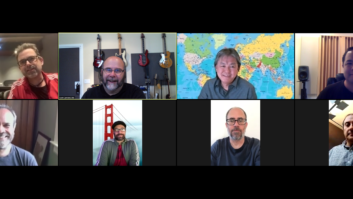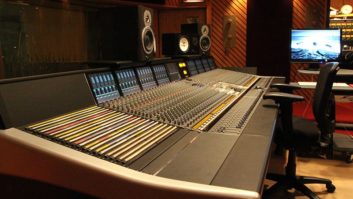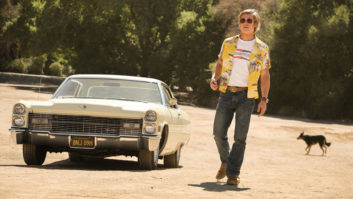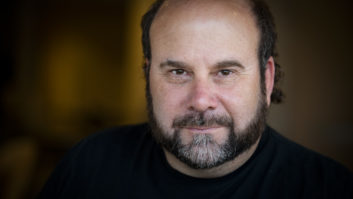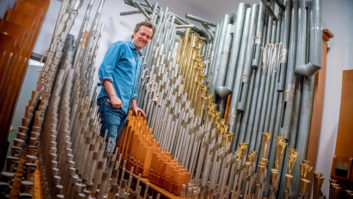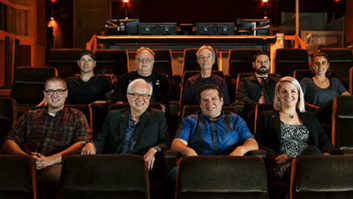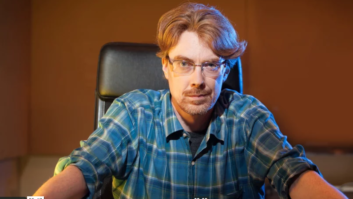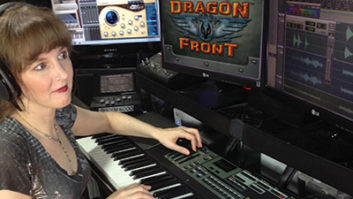Fantasy Studios’ studio director Jeffrey Wood and engineer Adam Munoz in Studio A control room. (Photo: Kim Harrington)by Christopher Walsh
Berkeley, CA–“The studio business is alive and well,” exclaims Jeffrey Wood, studio director of the legendary Fantasy Studios in Berkeley, California. Site of classic recordings by Creedence Clearwater Revival and Santana, hits by Counting Crows, Green Day, Journey, Huey Lewis & the News, Chris Isaak and Aerosmith, and, of course, much of the Fantasy Records catalog, Fantasy Studios has recently unveiled major renovations under its new owner, Wareham Development.
Though not a rebirth, rumors of the facility’s imminent closing had been circulating since the Fantasy label’s 2004 acquisition by the Concord Music Group. Owner Saul Zaentz’s 2007 sale of the Zaentz Media Center, which houses the studios, further fed the rumor mill. Far from closing the studios, however, Wareham Development invested over four million dollars in the building and studios, creating a state-of-the-art facility that retains the vibe of its storied history.
Originally launched in 1971 as the label’s in-house facility, Fantasy Studios has served legends including Sonny Rollins, Bill Evans and Herbie Hancock, as well as Creedence, for whom a studio with separate entrance was built. In addition to its many musical credits, Fantasy Studios also serves film and television post production work, including ADR, Foley, voiceover and soundtrack recording for memorable titles Apocalypse Now, The English Patient, Amadeus, Good Will Hunting, Fellowship of the Ring, The Sixth Sense and Finding Nemo.
Fantasy was opened to the public in 1980, and many top artists closely identified with the Bay Area made clear their affection for the Berkeley facility. “Don’t Stop Believing” and “Open Arms” from Journey’s mammoth 1981 release, Escape, En Vogue’s “My Lovin’ (You’re Never Gonna Get It),” and Green Day’s “When I Come Around” are among the hits put to tape in the ensuing decades. In 1999, as the music industry neared a commercial height it may never match, Carlos Santana’s duet with Matchbox Twenty vocalist Rob Thomas, “Smooth,” again shone the spotlight on Fantasy Studios: the song, recorded in Studio A, spent so many weeks atop its Hot 100 chart that Billboard magazine named it the top U.S. recording studio in 2000.
Studio A, at 28 by 49 feet, is “huge, with a super-high ceiling–at least two stories,” says Wood. The 16 by 19-foot control room houses a Solid State Logic 8056 G+ console with Ultimation, Pro Tools|HD3 rig, two Studer A800 MkIII 24-track tape machines and custom Augspurger monitors. The studio also features a nine-foot Yamaha C9 piano.
“Carlos [Santana] has done his last three CDs here,” says Wood, a producer and composer who became a producer in residence at Fantasy in 1995. “We do a lot of orchestral recording in Studio A. We had Roger Waters in with Bryn Terfel, the opera singer. We do gospel choirs in there. Bands love to record in there because of the sound of it–it’s the most requested tracking room in the Bay Area, because drum kits sound so great. We just had [musician /engineer] Bruce Kaphan doing the new Camper Van Beethoven release [ Popular Songs of Great Enduring Strength and Beauty]. He’s one of those people who won’t work anywhere else, because of the sound of the room.”
Fantasy’s Studio D is likewise a cavernous space, measuring 30 by 50 feet; an additional 18 by 30-foot string room features a marble floor. Studio D’s 18 by 21-foot control room houses an SSL 4000 E/G console with G Series computer, Pro Tools|HD3 system, two Studer A800 MkIII 24-track tape machines, Westlake 2-way mains and Meyer HD1 monitors. The live room features a seven-foot Yamaha C7 piano.
While retaining the original Fantasy vibe, Studio B illustrates the facility’s revitalization. The control room’s Trident 80B console has recently been supplemented with a Digidesign C|24 control surface (like the other rooms, Studio B is also Pro Tools|HD3-equipped). The control room also features Urei 813 and Dynaudio BM6A MkII monitors.
For indie and local artists, Studio B, just renovated and reopened, is more than just historically important. As in the past, Fantasy supports Bay Area artists, and the C|24-equipped studio B is perfect for artists on a budget, Wood explains.
“We work with everybody,” he says, “and we have a sliding scale, but reopening Studio B allows us a lot more flexibility to work more with the independent community, which we have been doing. I’m able to work at the same rate with Studios A and D, and whichever style of recording people do, we’ll point then towards one of the two rooms–they sound different, but they both have advantages. We’ve had a lot of independent bands in the bigger rooms, but Studio B gives us a lot more freedom, rate-wise, to work with bands and give them a lot more time to finish their project. And Studio B sounds great. It’s a small version of Studio A–it’s a very tall room and sounds beautiful. It’s not like anything is being downsized, and you still get the same mic choice, the same outboard gear, and a great sounding room. And we’re very happy with the C|24. There’s a lot more capability to it than we realized.”
Fantasy Studios is also available for film, video, photography and performance events, and also offers comprehensive format transfer services. “We have a large media transfer facility,” Wood explains. “We do a lot of archival work–we did the whole Monterey Jazz Festival archives, and work with Stanford University on their archives. We keep our [tape] machines for that–we try to keep a good collection of 2-, 4-, 8- and 16-track machines.”
The timing of Fantasy’s renovation is a boon for independent artists seeking professional results, many of them contributing to a resurgence in analog recording, says Wood. “People get to a point where they realize it does help to have experience involved,” he allows. “A lot of times people get to the point where they realize that recording in a living room sounds like it was recorded in a living room.”
The Zaentz Media Center remains a hub for the film, television and new media communities, contributing to a larger collective of creative professionals. “We service 25 or 30 film production companies in the building, besides Saul’s production company,” says Wood. “It’s a very vibrant community within the building, and an important part of the Berkeley filmmaking community.”
Its renovation complete, Fantasy Studios is also developing a program to foster a sense of community among Bay Area recording studios. “There is plenty of work for everybody,” Wood states. “But it’s about trying to keep everybody’s motivation up, too.
Fantasy Studios will be a featured facility of the 125th Audio Engineering Society Convention’s Technical Tours program, Wood confides. The 125th AES will be held October 2-5 at the Moscone Center in San Francisco.
“The whole thing here has been about technologically advancing the studios from where they were but keeping a nod to history,” Wood summarizes. “You can have the great analog stuff and still have the advantages of new technology.”
Fantasy Studios
www.fantasystudios.com
